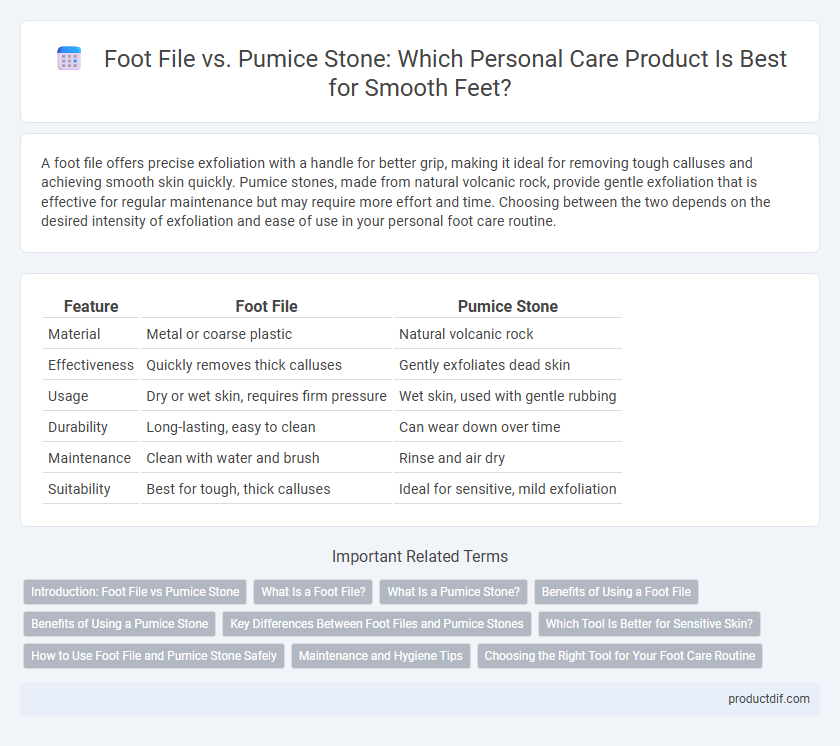A foot file offers precise exfoliation with a handle for better grip, making it ideal for removing tough calluses and achieving smooth skin quickly. Pumice stones, made from natural volcanic rock, provide gentle exfoliation that is effective for regular maintenance but may require more effort and time. Choosing between the two depends on the desired intensity of exfoliation and ease of use in your personal foot care routine.
Table of Comparison
| Feature | Foot File | Pumice Stone |
|---|---|---|
| Material | Metal or coarse plastic | Natural volcanic rock |
| Effectiveness | Quickly removes thick calluses | Gently exfoliates dead skin |
| Usage | Dry or wet skin, requires firm pressure | Wet skin, used with gentle rubbing |
| Durability | Long-lasting, easy to clean | Can wear down over time |
| Maintenance | Clean with water and brush | Rinse and air dry |
| Suitability | Best for tough, thick calluses | Ideal for sensitive, mild exfoliation |
Introduction: Foot File vs Pumice Stone
Foot files and pumice stones are essential tools for removing dead skin and calluses from the feet, each offering unique benefits. Foot files typically feature a coarse surface or metal blade designed for quick exfoliation, while pumice stones provide a gentler, natural abrasive surface formed from volcanic rock. Choosing between a foot file and pumice stone depends on skin sensitivity, the severity of calluses, and personal preference for maintenance routines.
What Is a Foot File?
A foot file is a personal care tool specifically designed to remove dry, dead skin and calluses from the feet with a coarse surface that efficiently smoothens rough patches. Unlike a pumice stone, which is a natural porous volcanic rock, a foot file often features a metal or abrasive surface that offers more precise control and faster exfoliation. Regular use of a foot file promotes softer, healthier feet and helps maintain overall foot hygiene, making it a popular choice in pedicure routines.
What Is a Pumice Stone?
A pumice stone is a porous volcanic rock used to exfoliate and remove dead skin cells from feet, effectively smoothing rough and calloused areas. Unlike a foot file, a pumice stone offers a natural abrasive texture that gently buffs away hardened skin while promoting better circulation. Its lightweight, water-resistant properties make it an essential tool in personal foot care routines for maintaining soft, healthy skin.
Benefits of Using a Foot File
A foot file effectively removes dead skin and calluses, promoting smoother and healthier feet with consistent use. Its design allows for precise control and targeted exfoliation, reducing rough patches without causing irritation. Unlike pumice stones, foot files often provide quicker results and are easier to clean, enhancing overall foot care hygiene.
Benefits of Using a Pumice Stone
A pumice stone effectively removes dead skin and calluses, promoting smoother and softer feet through gentle exfoliation. Its natural porous texture helps improve circulation and prevent cracked heels by maintaining healthy skin balance. Regular use supports overall foot hygiene, reducing the risk of infections and discomfort.
Key Differences Between Foot Files and Pumice Stones
Foot files typically feature a handle and a coarse abrasive surface designed for efficient removal of tough calluses and dead skin, offering better control and ease of use. Pumice stones are natural volcanic rocks that gently exfoliate by grinding away softer skin layers, ideal for sensitive or delicate foot areas. The key differences lie in material composition, durability, and the level of exfoliation intensity provided by each tool.
Which Tool Is Better for Sensitive Skin?
Foot files with fine-grit surfaces are generally better suited for sensitive skin because they provide gentle exfoliation without causing irritation or microtears. Pumice stones, made from volcanic rock, tend to be rougher and can be too abrasive for delicate skin, risking redness or discomfort. Choosing a foot file specifically designed for sensitive skin ensures effective callus removal while minimizing the risk of skin damage.
How to Use Foot File and Pumice Stone Safely
To use a foot file or pumice stone safely, soak feet in warm water for 10-15 minutes to soften skin before gently exfoliating calluses and dead skin. Avoid excessive pressure and limit usage to 2-3 times per week to prevent skin irritation or damage. Always clean and dry the tools thoroughly after each use to maintain hygiene and prevent bacterial growth.
Maintenance and Hygiene Tips
Foot files require regular cleaning with warm soapy water and thorough drying to prevent bacterial buildup and maintain effectiveness. Pumice stones should be soaked in a vinegar solution periodically to disinfect and allow complete drying between uses to avoid mold growth. Both tools benefit from storage in a dry, well-ventilated area to prolong longevity and ensure optimal foot hygiene.
Choosing the Right Tool for Your Foot Care Routine
Selecting the right tool for your foot care routine depends on your skin type and specific needs; foot files offer precise exfoliation for rough, callused skin while pumice stones provide gentle, natural abrasion ideal for daily maintenance. Foot files often feature ergonomic designs and abrasive surfaces like metal or coarse grit, making them effective for thick, hard skin. Pumice stones, made from volcanic rock, are eco-friendly and versatile but require consistent use to achieve smooth results without over-exfoliating delicate areas.
foot file vs pumice stone Infographic

 productdif.com
productdif.com